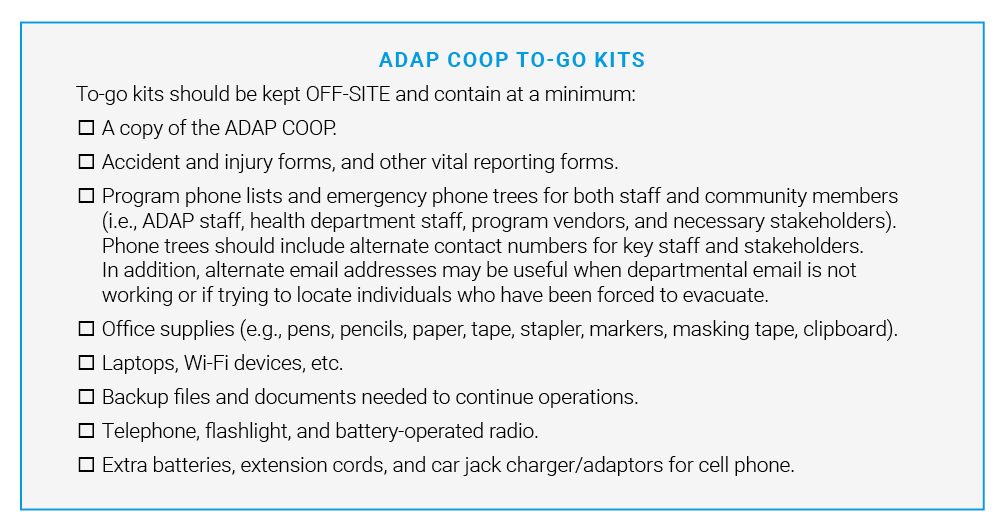
Continuity of Operations Planning
Continuity of operations planning is a federal initiative to ensure that Primary Mission Essential Functions (PMEFs) continue to be performed by agencies and departments during a wide range of emergencies and major events anticipated to cause service disruptions. The primary goal of establishing a Continuity of Operations Plan (COOP) is for agencies and departments to identify their PMEFs and establish procedures so their essential functions can be continued throughout, or resumed rapidly after, a disruption of normal activities.
An ADAP COOP should meet all of the following criteria:
- Can be implemented within 12 hours of an emergency situation
- Is integrated with the jurisdiction’s emergency plan
- Ensures the continuous performance of ADAPs essential daily functions during an emergency
- Protects essential equipment and vital records
- Facilitates decision-making during an emergency by establishing an identified chain of command of appropriate staff with pre-assigned duties and authority
- Achieves a timely and orderly recovery from an emergency so full services can be resumed for clients
A checklist for creating and maintaining a COOP can be found in Appendix 4.
COOP Development and Maintenance Considerations
1. Key Considerations for ADAP Emergency Preparedness Planning
-
Establish priorities/PMEFs and identify resources needed to re-establish these functions.
-
Develop a staffing plan response that includes key ADAP staff as well as alternative staffing options in the event that key staff are not able to be immediately located.
-
Conduct a hazard vulnerability assessment (see link in resources).
-
Identify Alternative Worksites:
Primary Backup Site – The ADAP will function from this primary site until full operations can return to the original office/location or until another location is identified.
Secondary Backup Site – A secondary site should be identified in the event that the primary backup site is affected by an emergency situation.
- Create logistics supplies/to-go kits to establish a mini operations center with relative ease in the event of an emergency (see text box).
-
Develop internal/external communications strategy if landline phones, cellular phones and email are unavailable. Determine specific alternate resources until normal communications are reestablished (e.g., satellite phones).
Develop and maintain a cyber network that fully integrates and supports secure remote/virtual operations that includes communication and file sharing capability.
2. Identify chain of command that integrates with the state plan. A COOP plan should include the following staff roles/responsibilities:
-
Chief Emergency Response Coordinator: responsible for the ADAP specific plan to continue care services and communication with ADAP clients. The ADAP administrator or their designee should fill this role for the program and would be responsible for activation and implementation of the ADAP emergency response plan.
-
Operations: responsible for maintaining contact with the wholesaler, Pharmacy Benefits Manager (PBM), and/or area pharmacies, including sharing data.
-
Logistics: coordinates services between ADAP and HIV care service providers (including RWHAP grantees and subgrantees) throughout the state and assists the Chief Emergency Response Coordinator.
-
Communication: ensures that clients and key stakeholders have current information on accessing medications from existing central or network pharmacies, expanded network pharmacies, or via an ADAP in a neighboring state, as well as any relevant changes to early refill or 60- or 90-day fill policies, while simultaneously ensuring the confidentiality of client records.
-
Planning: maintains and updates the ADAP’s emergency response plan, ensuring that lessons-learned are incorporated into the plan in a timely manner.
3. Prioritize essential functions for an ADAP
-
Develop plan to ensure continuity of ADAP drug acquisition, implementing a short-term plan to allow extended supplies or early refills of medications, including coordination with key vendors (e.g., wholesalers and PBMs).
-
Develop alternative distribution methods including local health departments, hospital, or community-based distribution systems.
-
Ensure that back-up data and computer file servers are stored off-site, if possible. In the event of a power outage, it may be beneficial to implement a paper backup system and print off relevant program data on a weekly or biweekly basis during an emergency.
-
Ensure there is a plan to make payments to contractors.
-
Establish how new clients will be determined eligible and subsequently enrolled, and how existing clients will be recertified.
ADAP Emergency Preparedness and Service Disruption State Examples
The following are links to examples of emergency preparedness and service disruption plans established by ADAPs in two states.

